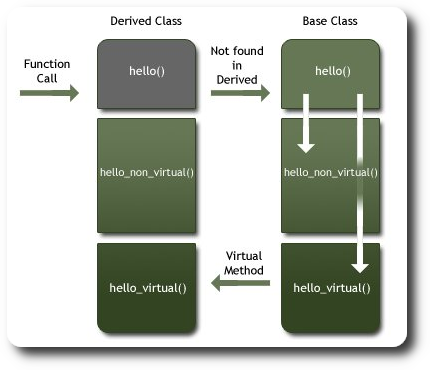“All methods in Python are effectively virtual”
Dive Into Python really is one of the best programming books I have ever laid my hands on. Short, concise and to-the-point. The somewhat unorthodox approach of presenting an alien-looking program at the start of each chapter and then gradually building towards making it comprehensible is extraordinarily captivating. With that said, here’s an excerpt from the chapter introducing Python’s object orientation framework:
Guido, the original author of Python, explains method overriding this way: “Derived classes may override methods of their base classes. Because methods have no special privileges when calling other methods of the same object, a method of a base class that calls another method defined in the same base class, may in fact end up calling a method of a derived class that overrides it. (For C++ programmers: all methods in Python are effectively virtual.)” If that doesn’t make sense to you (it confuses the hell out of me), feel free to ignore it. I just thought I’d pass it along.
If you were able to comprehend the full meaning of that paragraph in a single go, you’re probably (a) Guido van Rossum himself (b) Don Knuth (c) Pinnochio.
Neither of which happens to be my identity, so it took me a few dozen re-reads to grasp the idea. It brought back memories of an interesting question that I used to ask students while I was working as a teacher’s assistant for the C++ course: “What is a virtual function?” The answer always involved pointers and polymorphism; completely ignoring any impact virtual functions would be having on inheritance in referential/non-pointer scenarios. (Considering that most of the C++ books never attempt to portray the difference either, I didn’t blame the students much.) Confused again? Here’s some more food for thought: Python does not even have pointers, so what do these perpetually virtual functions really entail in its universe? Let’s make everything peachy with a nice example.
Consider a Base class in C++ which defines three functions:
hello()hello_non_virtual()hello_virtual()
The first function, i.e., hello() calls the latter two (hello_non_virtual() and hello_virtual()). Now, we inherit a Derived class from the Base, and override the functions:
hello_non_virtual()hello_virtual()
Note that the hello() function is not defined in the Derived class. Now, what happens when someone calls Derived::hello()? The answer:

Since Derived::hello() does not exist, Base::hello() is called instead. Which, in turn, calls hello_non_virtual() and hello_virtual(). For the non-virtual function call, the Base::hello_non_virtual() function is executed. For the virtual function call, the overridden Derived::hello_virtual() is called instead.
Here’s the test code for C++:
1 2 3 4 5 6 7 8 9 10 11 12 13 14 15 16 17 18 19 20 21 22 23 24 25 26 27 28 29 30 31 32 33 34 35 36 37 38 39 | #include <iostream> using namespace std; class Base { public: void hello() { cout<<"Hello called from Base"<<endl; hello_non_virtual();="" hello_virtual();="" }="" void="" hello_non_virtual()="" {="" cout<<"hello="" called="" from="" non-virtual="" base="" function"<<endl;="" virtual="" hello_virtual()="" };="" class="" derived="" :="" public="" public:="" int="" main()="" d;="" d.hello();="" return="" 0;="" <="" pre=""> And its output: <blockquote> Hello called from Base Hello called from non-virtual Base function Hello called from virtual Derived function </blockquote> Similarly, a Python program to illustrate the statement <em>"all methods in Python are effectively virtual"</em>: <pre lang="python" line="1">class Base: def hello(self): print "Hello called from Base" self.hello_virtual() def hello_virtual(self): print "Hello called from virtual Base function" class Derived(Base): def hello_virtual(self): print "Hello called from virtual Derived function" d = Derived() d.hello() |
Output:
Hello called from Base
Hello called from virtual Derived function
I hope this clears up the always-virtual concept for other Python newcomers as well. As far as my experience with the language itself is concerned, Python is s**; simple as that. Mere two days after picking up my first Python book for reading, I have fallen in love with its elegance, simplicity and overall highly addictive nature.
Tags: C++, Class, Code, Dive Into Python, Example, Flag 42, Function, Method, Object Oriented Programming, OOP, Open Source, Polymorphism, Python, Virtual



